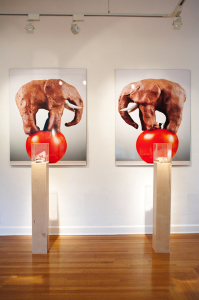 Thomas Müller’s Majestic (diptych) dominates the north end of Scripps College’s Ruth Chandler Williamson Gallery. The piece includes two blown-up photographs of ceramic elephants perched atop ripe tomatoes and the reality behind the pictures–two tiny statues toppled by the tomato’s eventual decay. It’s a striking piece of modern momento mori and a centerpiece of the 67th Ceramic Annual, the longest-running contemporary ceramics exhibition in the United States.
Thomas Müller’s Majestic (diptych) dominates the north end of Scripps College’s Ruth Chandler Williamson Gallery. The piece includes two blown-up photographs of ceramic elephants perched atop ripe tomatoes and the reality behind the pictures–two tiny statues toppled by the tomato’s eventual decay. It’s a striking piece of modern momento mori and a centerpiece of the 67th Ceramic Annual, the longest-running contemporary ceramics exhibition in the United States.
Titled “Making Fun,” this year’s Annual runs January 22-April 3 and is curated by Pitzer College’s assistant professor of ceramics, Tim Berg. The result is an exhibit both humorous (the corpse of Mickey Mouse rests next to a Ming vase with robotic legs bursting from its base) and complex (Majestic sardonically reflects on the fleeting nature of life). It’s also perfectly in tune with the mission of the Annual, which strives to radically redefine itself each year.
One of the most exciting aspects of the Ceramic Annual is its focus on presenting new and original perspectives year after year. It’s an approach that keeps it new, fresh, and supported by artists and art lovers from all over the United States. The Scripps Ceramic Annual is also one of the few “invitation only” exhibitions in the country: curators, who are often artists themselves, are invited to submit proposals to curate the Annual. The candidate selected then creates the exhibition, with the assistance of the Gallery staff. In this way, the Annual offers a completely fresh perspective every year. And since the theme varies so much from exhibit to exhibit, patrons are guaranteed to find a broad range of ceramic art, from functional ware to sculpture to installations.
First started by Scripps College ceramics professor William Manker, the Annual took on new dimensions when artist and professor Paul Soldner became curator in 1959. Soldner used his extensive network to reach out to prominent artists and professionals and have them nominate emerging ceramic talent. Each selected artist had several pieces displayed, instead of just one work, as was common practice. Many attribute the great and lasting success of the Ceramic Annual to these innovations.
When Mary MacNaughton, current director of the Williamson Gallery, took over for Soldner, she and Collections Manager Kirk Delman realized they would have to transform the format of the show yet again.
“We didn’t have the same, large network [Paul] had,” Delman explains. “So we decided that– instead of Mary curating the exhibit herself–we would invite a guest curator, someone with a specific, intriguing vision for the exhibit, each year.”
“The Ceramic Annual is fun because the curator and the artists come to campus,” says Julia Berryman ’12, a student intern at the Williamson Gallery. “The Gallery features guest speakers before the exhibit opens, and this really connects it to the greater community. Most museum-goers don’t get the opportunity to really understand the art that way.”
MacNaughton and Delman invite curator candidates to submit a proposal explaining their vision for the show. The curator has a lot of responsibilities, from selecting the artists, choosing their work, helping to create the catalog, figuring out the configuration of the show, to planning the fall lecture. The gallery staff then act as facilitators, helping the curator and artists to complete their visions. “We don’t edit, and we don’t censor,” says Delman.
“The shows are started about a year and a half in advance, so it’s important for the curator to stay on top of everything,” MacNaughton adds.
But what about the future of the Ceramic Annual? Will it survive for another 67 years? Delman and MacNaughton seem to think so.
“The challenge is to keep it fresh,” says Delman. “Our goal is to continue bringing important and provocative exhibits to Southern California every year.” There is also hope of emphasizing artist education in the upcoming years by bringing more and more ceramics professors to the show.
“Currently, ceramics is very fashionable in the art world,” notes Berg. “But I am sure ceramics will go out of fashion just as quickly as it became fashionable. What won’t go out of fashion is Scripps’ ability to, year after year, mount a compelling exhibition of contemporary ceramics that challenges people to think about where we are headed as a field and as a community.”

